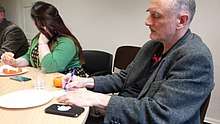Sebastian Rahtz
Sebastian Patrick Quintus Rahtz (13 February 1955 – 15 March 2016) (SPQR) was a British digital humanities information professional.
Sebastian Patrick Quintus Rahtz | |
|---|---|
 Sebastian Rahtz discussing TEI Simple Processing Model, Berlin March 2015 | |
| Born | 13 February 1955 Bristol, England |
| Died | 15 March 2016 (aged 61) Oxford, England |
| Resting place | Oxford, England |
| Nationality | British |
| Other names | Stormageddon Rahtz |
| Alma mater | Institute of Archaeology, University of London University of Oxford |
| Known for | TeX, Text Encoding Initiative (TEI) |
| Spouse(s) | Leonor Barroca |
| Children | 2 |
| Scientific career | |
| Institutions | University of Exeter, University of Southampton, University of Oxford |
| Thesis | Funerary epitaphs and iconography : an analysis of the Protestant Cemetery, Rome (1974) |
Life
Born in 1955 to Somerset-focused archaeologist Philip Rahtz, Sebastian trained in archaeology, before delving into the computing realm via Lexicon of Greek Personal Names (LGPN) in 1982.[1]
He was a long-term contributor to multiple communities in the broader digital humanities, including LGPN, TeX,[2][3] computer methods in archaeology,[4] and the Text Encoding Initiative (TEI).[5] Sebastian's legacy also includes the vital contributions which he made to building and maintaining much of the TEI's technical Infrastructure and related software such as their XSLT Stylesheets and web-based document conversion engine OxGarage [6] CLAROS,[7] the Oxford Text Archive,[8] Text Creation Partnership [9] and OSS Watch.[10]
From 1999-2015 he worked at Oxford University Computing Services (OUCS) which on 1 August 2012 merged with two other departments to become IT Services.[11] He joined the department in 1999 from Elsevier, having previously been a lecturer in Humanities Computing at the University of Southampton. He became Head of the Information and Support Group in OUCS, and then joint Director (for Research) of the Academic IT Group in 2010 and a member of the senior management team. In 2014 he was appointed Chief Data Architect.[12] He took medical retirement from IT Services, University of Oxford in the late summer of 2015.
He died in 2016, from brain cancer.[13]
Selected works
- Kicking and screaming: Challenges and advantages of bringing TCP texts into line with Text Encoding Initiative. J. Cummings and S. Rahtz, in Bodleian Libraries, University of Oxford, "Revolutionizing Early Modern Studies"? The Early English Books Online Text Creation Partnership, (2012). Retrieved from http://ora.ox.ac.uk/objects/uuid:f9667884-220b-4ec9-bb2f-c79044302399
- The LaTeX Web Companion: Integrating TeX, HTML, and XML. M. Goossens, S. P. Q. Rahtz, and S. Rahtz. Addison-Wesley
- Guide to LaTeX. H. Kopka, P. W. Daly, and S. P. Q. Rahtz. Addison-Wesley
- The LaTeX companion. F. Mittelbach, M. Goossens, J. Braams, D. Carlisle, and C. Rowley. Addison-Wesley
- LaTeX: Einführung. H. Kopka and S. Rahtz. Addison-Wesley
- The LaTeX Graphics Companion: Illustrating Documents with TeX and Postscript (Tools and Techniques for Computer Typesetting). M. Goossens, F. Mittelbach, S. Rahtz. D. Roegel, and H. Voss. Addison-Wesley
- A style option for rotated objects in LaTeX (1992), 156-180. S. Rahtz and L. Barroca.
- Archaeology and the Information Age: A global perspective (1992), P. Reilly and S. Rahtz (eds.), One World Archaeology. Routledge.
Impact
In September 2016, Oxford University ran a whole-day event celebrating his life, with speakers talking about his projects.[14] Many of the talks are available as podcasts.[15]
Further reading
- Sebastian Rahtz (1955–2016): A brief memoir by Lou Burnard
- R.I.P. — S.P.Q.R Sebastian Patrick Quintus Rahtz (13.2.1955–15.3.2016) by Frank Mittelbach and Joan Richmond
- 29.789 Sebastian Rahtz 1955-2016 by Willard McCarty
References
- "Homepage, Lexicon of Greek Personal Names, University of Oxford". Lgpn.ox.ac.uk. Retrieved 23 March 2016.
- "Sebastian Rahtz - Interview - TeX Users Group". Tug.org. Retrieved 23 March 2016.
- Contact Author. "Contributor Sebastian Rahtz". CTAN. Retrieved 23 March 2016.
- "Sebastian Rahtz". CAA International. 16 February 2016. Retrieved 23 March 2016.
- "iii. Preface and Acknowledgments - The TEI Guidelines". Tei-c.org. 15 October 2015. Retrieved 23 March 2016.
- "OxGarage document conversion service". Retrieved 24 March 2016.
- "CLAROS: the World of Ancient Art on the Semantic Web". Retrieved 24 March 2016.
- "Oxford Text Archive". Retrieved 24 March 2016.
- Wynne, Martin. "The Oxford Text Archive – downloads in 2015 - Martin Wynne".
- "OSS Watch: independent advice on free and open source software". Retrieved 24 March 2016.
- "Sebastian's Rahtz minimal home page". Users.ox.ac.uk. Archived from the original on 25 March 2016. Retrieved 3 April 2017.
- "IT Architecture Group, University of Oxford". Archived from the original on 27 September 2016. Retrieved 27 September 2016.CS1 maint: BOT: original-url status unknown (link)
- "Gmane Loom". comments.gmane.org.
- "SPQR a digital legacy: what Sebastian Patrick Quintus Rahtz did for us". Oxford e-Research Centre. 7 September 2016.
- "Sebastian Rahtz, a celebration of his work - University of Oxford Podcasts - Audio and Video Lectures". podcasts.ox.ac.uk.
External links

- google scholar